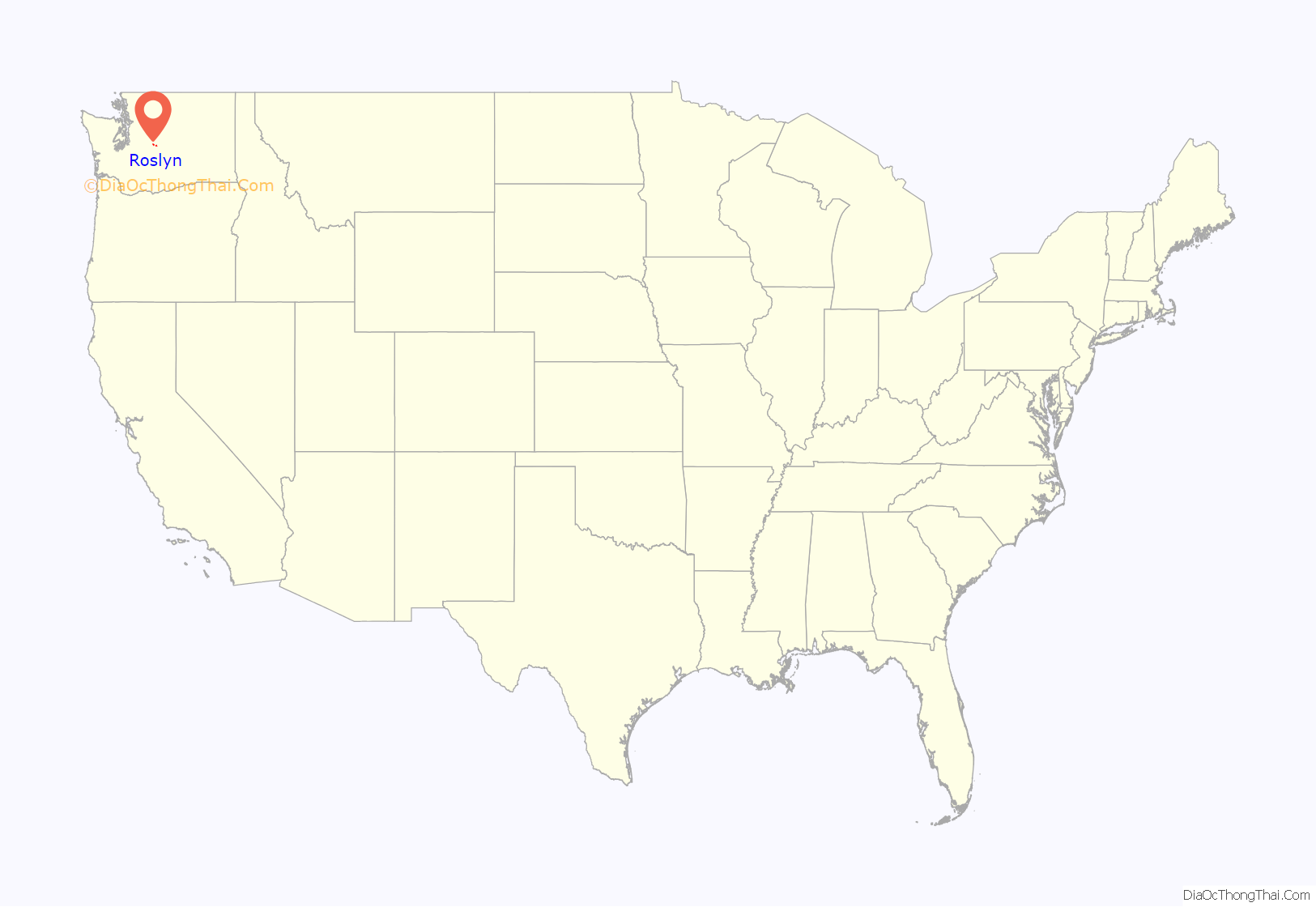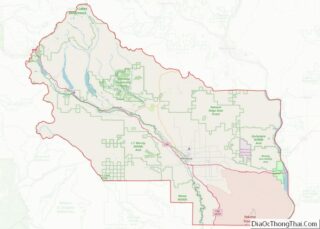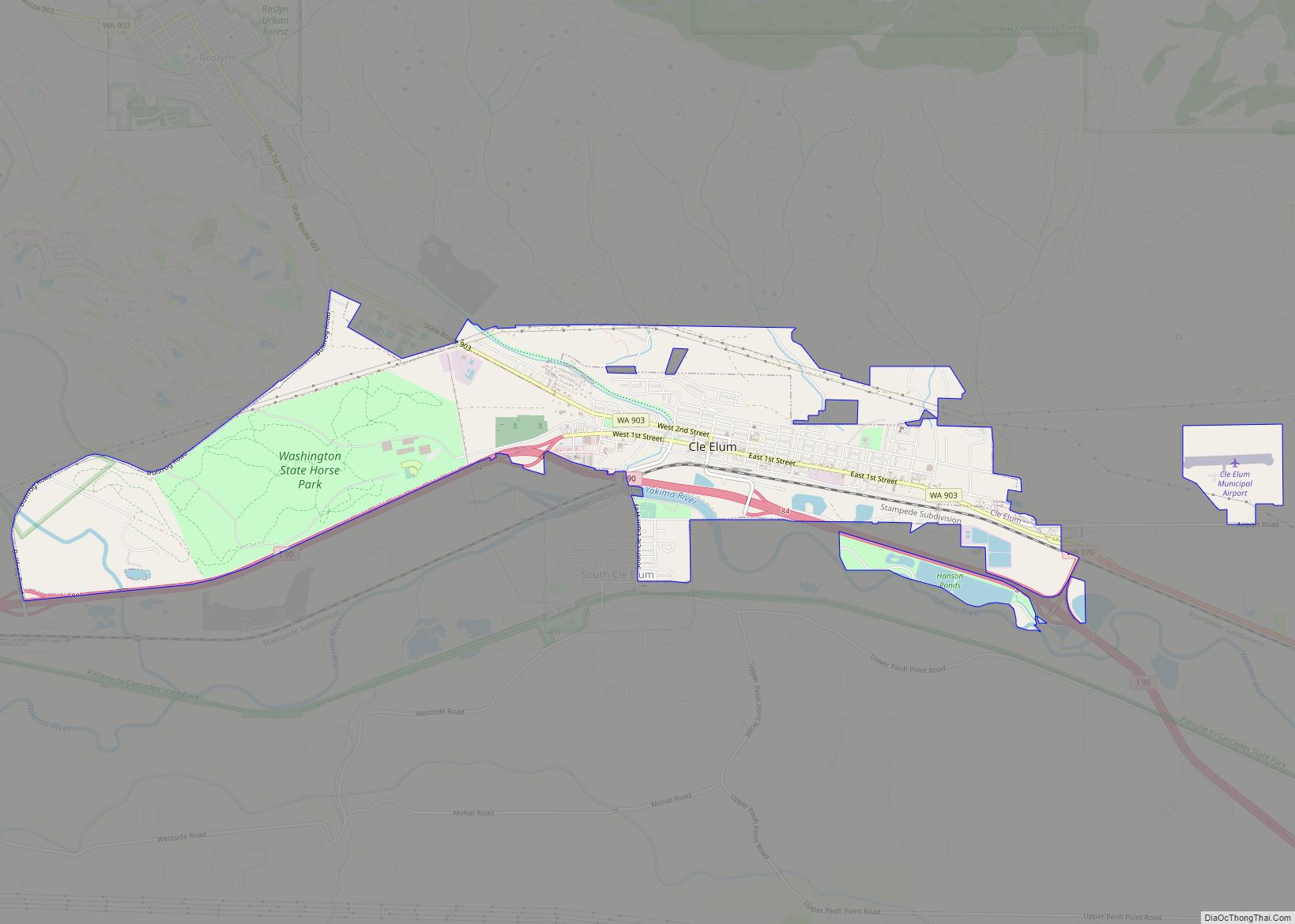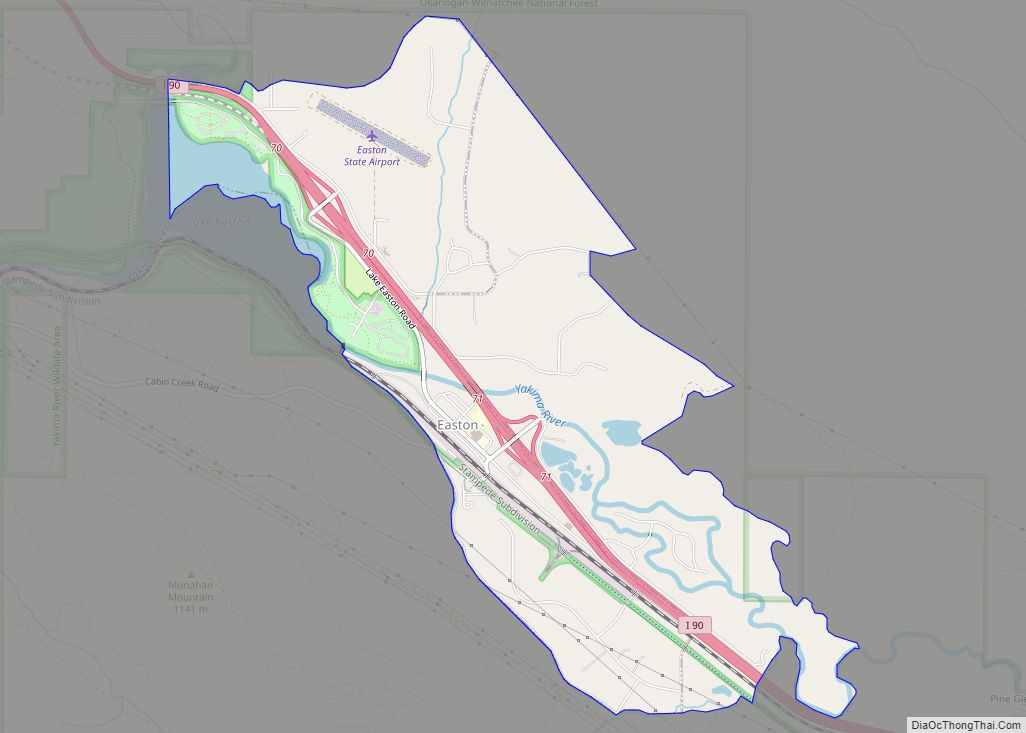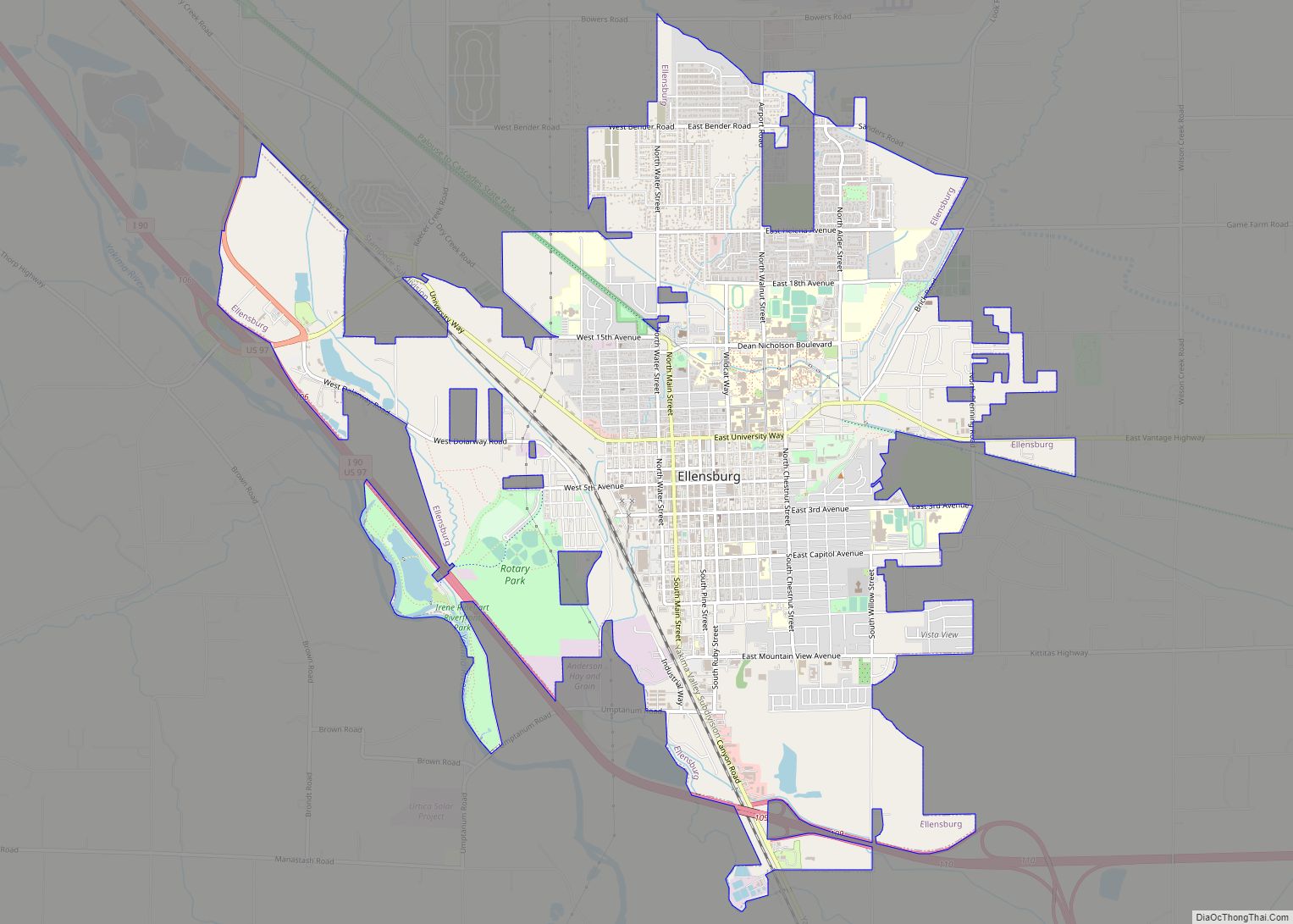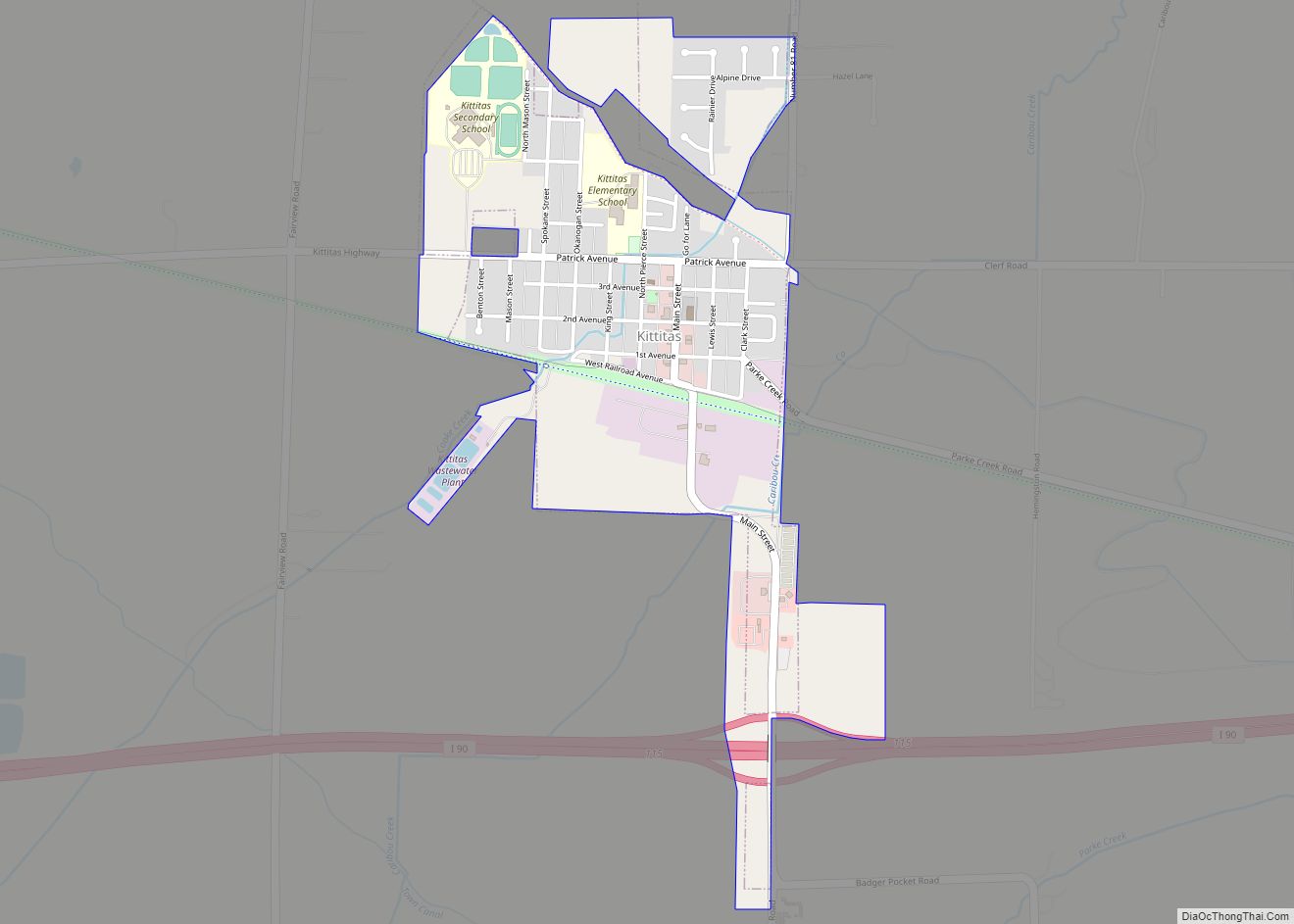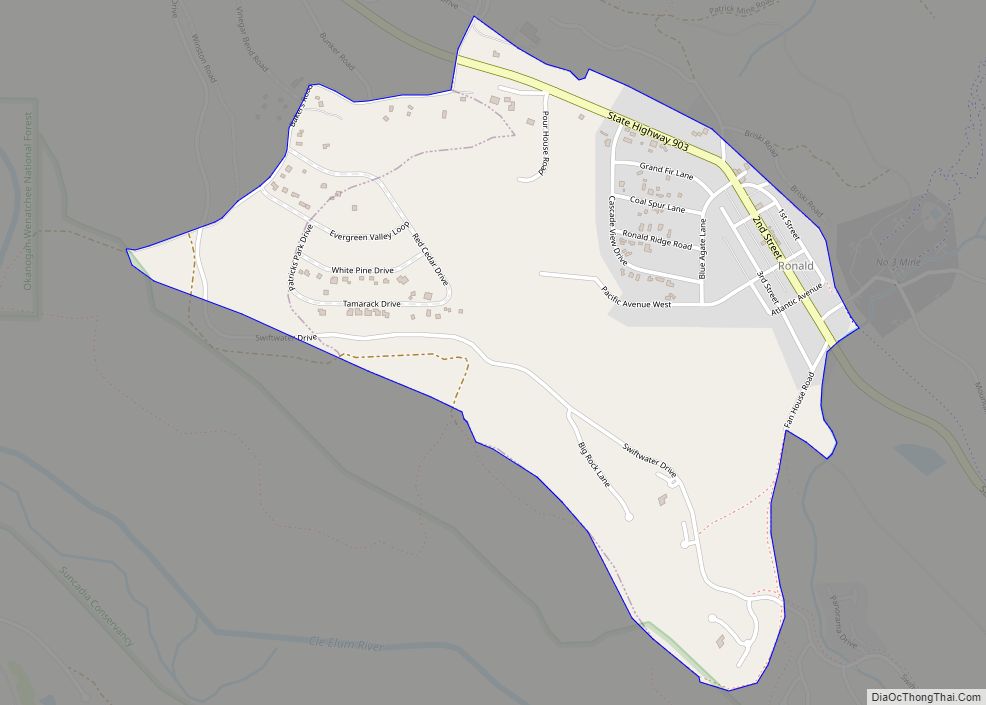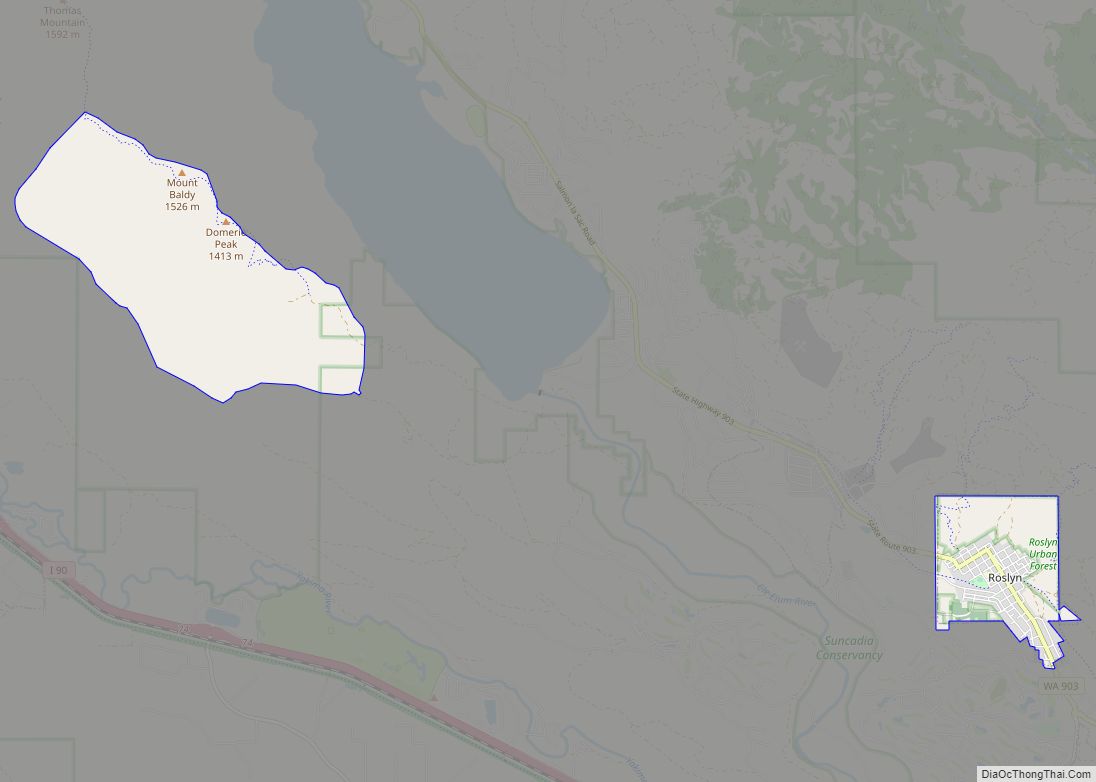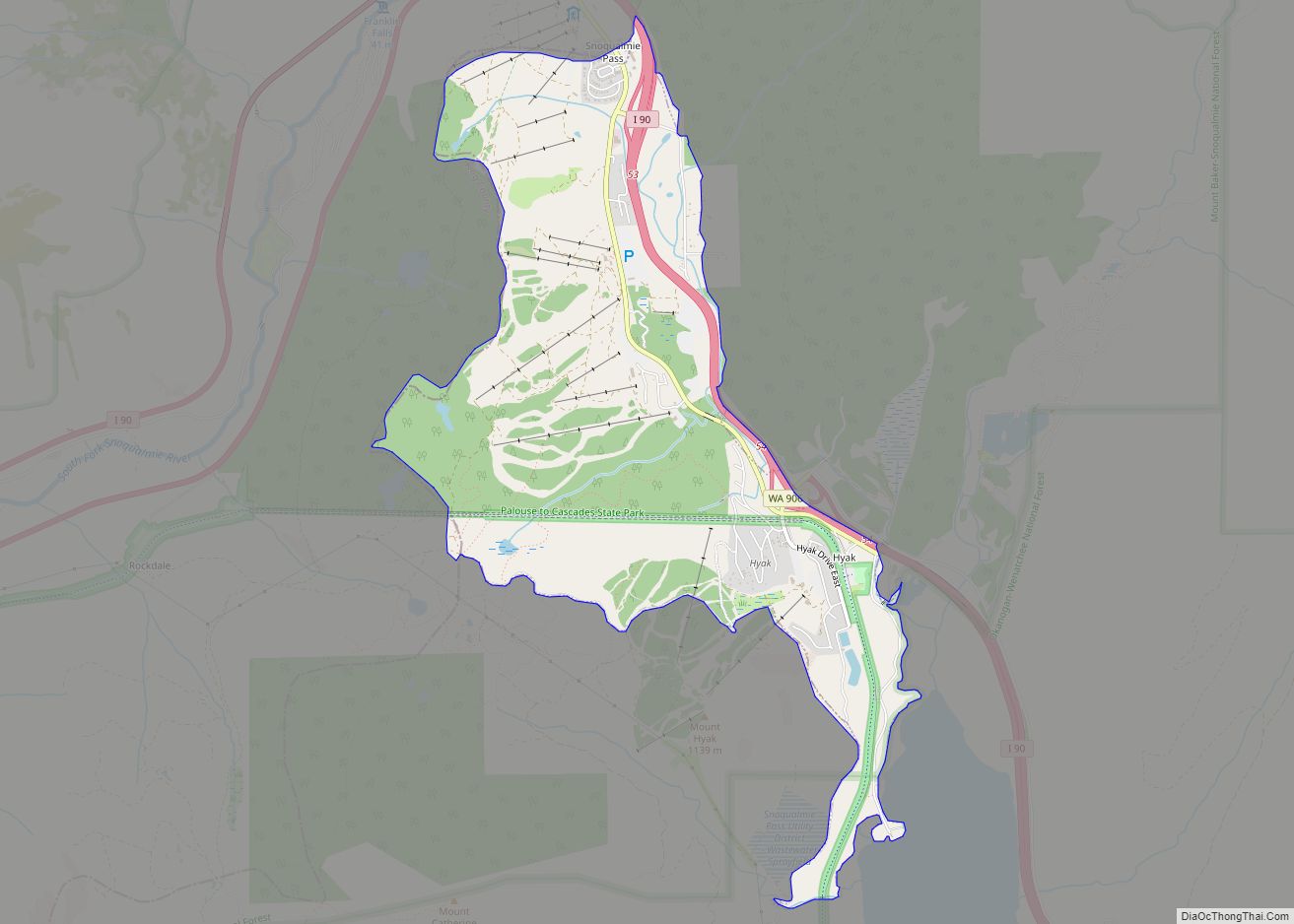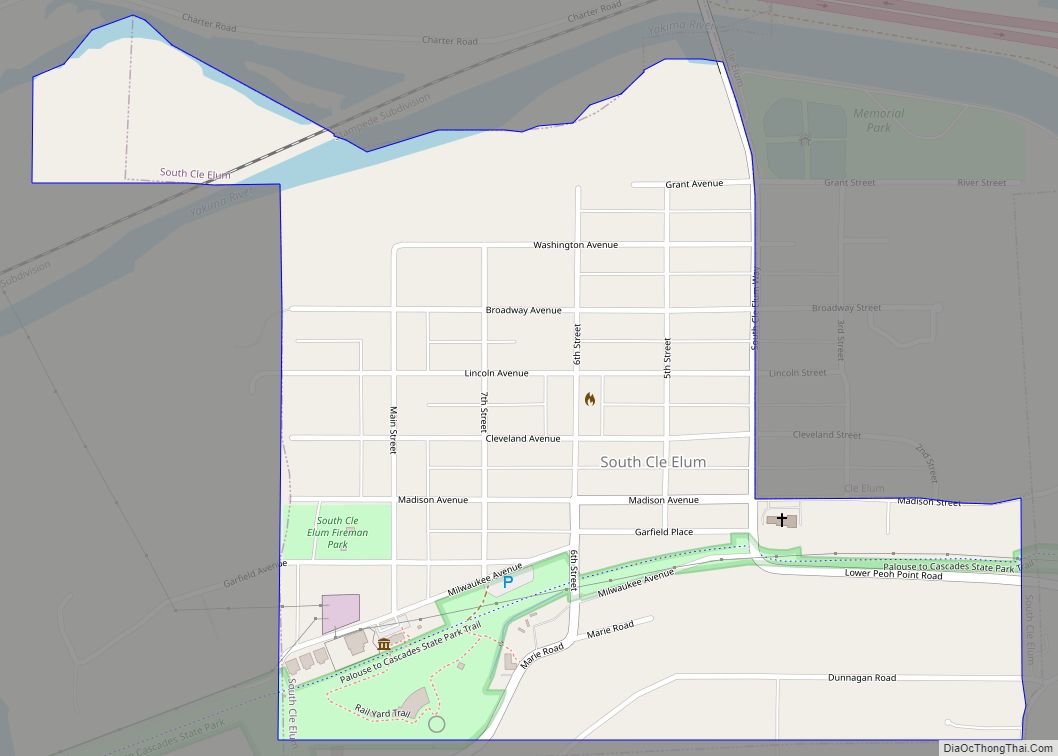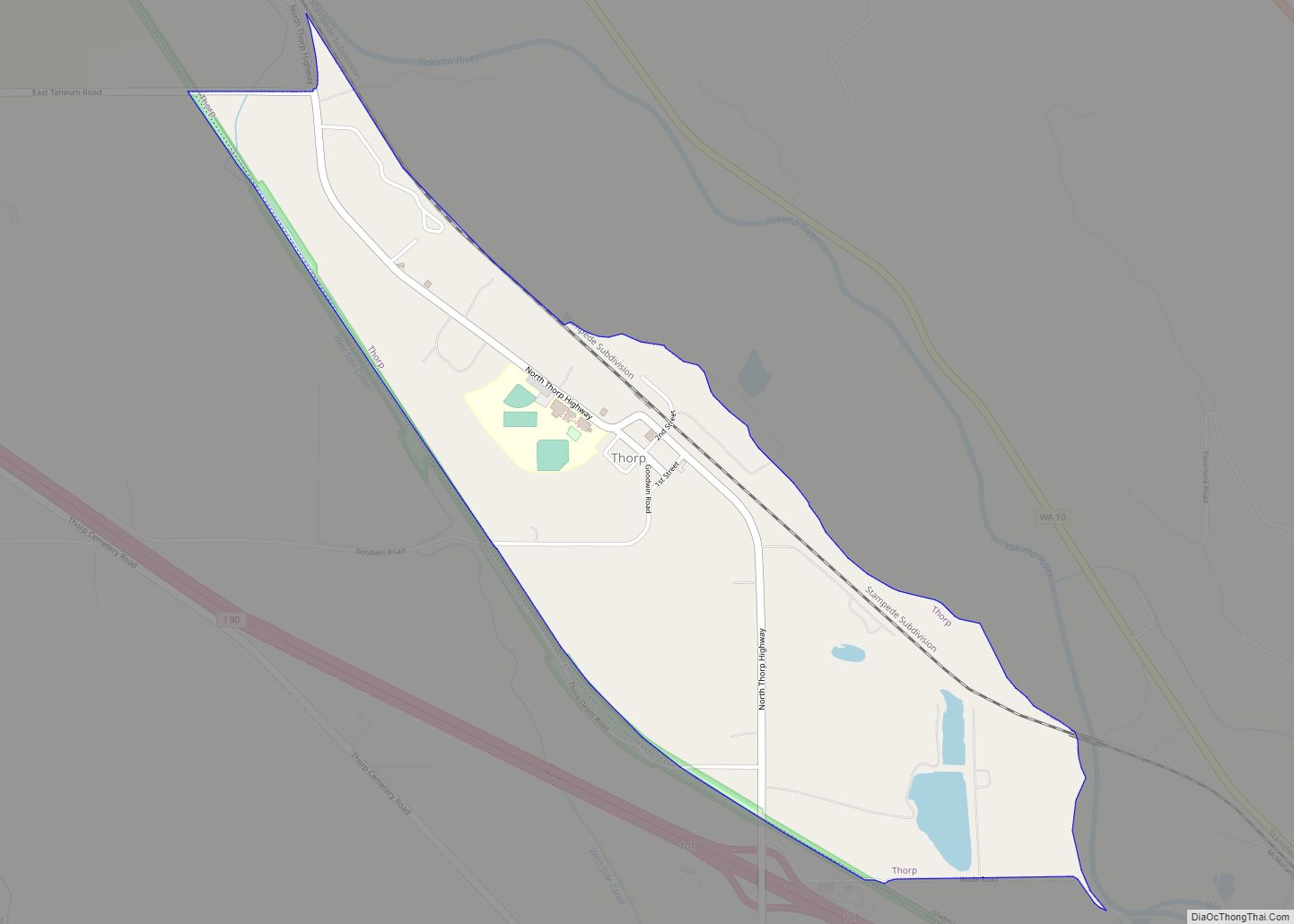Roslyn is a city in Kittitas County, Washington, United States. The population was 893 at the 2010 census. Roslyn is located in the Cascade Mountains, about 80 miles east of Seattle. The town was founded in 1886 as a coal mining company town. During the 20th century, the town gradually transitioned away from coal, and today its economy is primarily based on forestry and tourism. The town was the filming location for The Runner Stumbles, Northern Exposure, and The Man in the High Castle. Many of the town’s historical structures have been preserved, and its downtown was added to the National Register of Historic Places in 1978.
| Name: | Roslyn city |
|---|---|
| LSAD Code: | 25 |
| LSAD Description: | city (suffix) |
| State: | Washington |
| County: | Kittitas County |
| Elevation: | 2,247 ft (685 m) |
| Total Area: | 4.39 sq mi (11.37 km²) |
| Land Area: | 4.39 sq mi (11.37 km²) |
| Water Area: | 0.00 sq mi (0.00 km²) |
| Total Population: | 893 |
| Population Density: | 218.22/sq mi (84.25/km²) |
| ZIP code: | 98941 |
| Area code: | 509 |
| FIPS code: | 5360055 |
| GNISfeature ID: | 1525216 |
Online Interactive Map
Click on ![]() to view map in "full screen" mode.
to view map in "full screen" mode.
Roslyn location map. Where is Roslyn city?
History
Early history
Coal deposits were first noted in the Roslyn area in 1883, with a large vein discovered at the upper Smith Creek canyon in 1885 by C.P. Brosious, Walter J. Reed, and Ignatius A. Navarre. Roslyn was platted in 1886 by Logan M. Bullet, vice president of the Northern Pacific Coal Company, at the time that the company initiated the first commercial coal mining operations there, to support railway operations.
Throughout the mid-1880s, the Northern Pacific Railway, the parent of Northern Pacific Coal Company, pushed from the east to reach Puget Sound across the Cascade Mountains. The Northern Pacific began building across Stampede Pass just west of Roslyn, approaching from Wallula in the east and Tacoma in the west. A 77-mile (124-km) gap remained in 1886. In January of that year, Nelson Bennett was given a contract to construct a 9,850 foot (3,002 m) tunnel under Stampede Pass, completing it in 1888. Roslyn, which lies on the route to Stampede Pass, provided the coal for the railway construction work as well as the continuing railroad operations.
Between 1886 and 1929, immigrant workers from countries such as Italy, Poland, Slovakia, Germany, Lithuania, Slovenia, Serbia and Croatia as well as from England, Ireland, Scotland and Wales came to work in the mines. These immigrants maintained the traditions of their homelands, as seen in the historic Roslyn Cemetery, with its 26 sections for distinct ethnic and lodge cemetery areas. Many Roslyn residents today are descendants of these immigrant miners.
Roslyn’s peak coal mine production of nearly 2 million tons was reached in 1910. As coal-fired steam trains were being replaced by diesel power, the mines began to shut down in the 1920s. Although the local coal mines were far from played out (approximately 80% of the coal in the Roslyn mines remains unextracted), the last mine in the area closed in 1963 as business became unprofitable. With the loss of jobs, an exodus of residents ensued. In the mid-1970s, Roslyn began to flourish again as artists and others rehabilitated the town’s houses and commercial buildings and settled there. Some individuals own second homes in Roslyn, while working and living full-time in Seattle or Tacoma, for instance.
As Roslyn was a “company town”, life in the early years was centered around the production of coal. Most of the citizens of the town worked either for the Northern Pacific Coal Company or in one of the smaller businesses monopolized by the company, or were family members of someone who did. A hub of life in the town was the Northwestern Improvement Company Store, now listed on the National Register of Historic Places; it still stands at the corner of First Street and Pennsylvania Avenue.
Like many 19th-century American towns and cities, where risk of fires was high, Roslyn had a major fire in 1888, which destroyed most of its commercial district. Many buildings constructed after the fire used fire-resistant brick and sandstone. Some of these historic structures are still in use, including the 1889 Brick Tavern and the circa-1890 Fischer Building.
During its days of prosperity, the Northern Pacific Coal Company built the Roslyn Athletic Club for miners and their families. It was completed in 1902 and contained a gym, meeting rooms, and a bowling alley. Roslyn’s public library, which was founded in 1898, moved into the Roslyn Athletic Club building in 1918. It continues to serve the community from this location.
Most of the town’s 500 homes were built in the 1920s on land owned by the railroad. The 1920s-era commercial district consisted of four square blocks, of which about one dozen buildings remain as representatives of western frontier commercial architecture. Roslyn has many examples of Victorian elegance in its surviving buildings, as well as simple miner’s shacks. The town of Roslyn was listed on the National Register of Historic Places in 1978. Recently, Roslyn became a Certified Local Government. Its Historic Preservation Commission restored the Roslyn Cafe, a local landmark.
Roslyn’s railroad tracks have been removed and replaced by the Coal Mines Trail which runs from Cle Elum through Roslyn to Ronald. A walk on the trail affords visitors a look at the remains of Roslyn’s mines and railroad depot site. The Roslyn Museum houses an extensive collection of photos and mining memorabilia, and features an exhibit on Roslyn’s unique ethnic cemeteries.
Most recently, recreation and tourism have become the chief drivers of the economy. The business community has worked to bring in more visitors through annual festivals, including the Manly Man Festival in June, the Pioneer Days Picnic, and a Coal Mining Festival associated with Coal Mining History Week each August.
Knights of Labor Strike of 1888 and African American migration
Tensions between management and labor in the Roslyn mines began spilling over in the summer of 1888, when management laid off a number of labor union workers who were petitioning for eight-hour work days and higher wages. These layoffs led to a labor strike by the Knights of Labor, which shut down the mines. Northwest Coal Company, which conducted mining operations at Mine No. 3, a few miles away in nearby Ronald, responded by recruiting strikebreakers. This included 50 black laborers from the East and Midwest who were transported by train with almost 40 private armed guards. The recruitment of these armed forces raised the interest of Territorial Governor Eugene Semple when he heard that they harassed area residents calling themselves U.S. Marshals. This was considered a paramilitary challenge to Washington Territory authority and Semple ordered the local sheriff to disperse the unit.
Semple visited Roslyn to investigate Northwest Coal Company’s practices and condemned the company for hiring a private militia on suppositions that the white strikers would attack black laborers and overpower police forces. Semple’s report describes the residents as “intelligent” and “law-abiding,” and the company’s suppositions as erroneous. He did not intervene on the labor disputes, and strikers continued to lose ground in negotiations.
In a span of two years, the company recruited more than 300 black laborers from Virginia, North Carolina, and Kentucky. Many relocated with families, and this migration was the largest increase in the African-American population of Washington Territory up until that time. Sheriff Packwood of Kittitas County reported to Semple that relations between out-of-work white workers and the black population were strained with potential to turn violent. However, after the strike broke tensions reduced, and whites reconciled with working along black miners. As the regional coal industry boomed, competition for employment reduced, and eventually workers organized as equals with United Mine Workers.
Mine accident of 1892
In 1892, 45 miners were killed in an explosion at Mine No. 1 near Roslyn, the deadliest mining accident in Washington history.
1892 Ben E. Snipes and Co. bank robbery
On September 24, 1892, a group of five bandits, known criminals and affiliates of Butch Cassidy, held up the Roslyn branch of the Ellensburg-based Ben Snipes Bank. Two of the men stood guard with the horses while the other three went inside. One of the men approached the cashier asking for what ever was in the already open vault. The other two men kept the customers in the store quiet, one of them was Dr. Lyon who would later be murdered and the case never solved. The five men rode away with $5,000 or $10,000, depending on the source. It is thought that the men were expecting the coal miner’s pay, $40,000 coming from Tacoma, would have been held in the bank. However, the money was sent directly to the coal company.
The sheriff and his posse soon chased after the men and into the hills of Teanaway. In November 1892, three men were brought into the jail and were asked to be identified by the witnesses of the robbery. Cal, Kimize, and Zachary Hale were taken in and arrested. Cal was the only one of the three men to be charged and found guilty of the crime.
A couple of months later, the Kittitas County Courts, received a letter from Utah, telling them that they had convicted the wrong man. Cal Hale was set free and the search for Tom, George, William and Fred McCarthy, as well as Ras Lewis (alias Ras Christiansen and Matt Warner). In April 1893, a posse traveled down into Oregon looking for these bandits. George and William went with the men without a fight. Tom, Fred and Ras took off and were soon lost. Later that month the Yakima County Attorney received a letter from Rosa Lewis, Ras Lewis’ wife, stating that she knew that the men had done it and she was tired of her husbands battle with the law. Soon after the Sheriff and his posse went to the cabin at the “7 U Ranch”, owned by Fred Beezley, that Ras and his wife were leasing.
All five men were eventually taken into custody and tried. George and Ras attempted to break free and ran around the city of Ellensburg until the sheriff was able to detain them. There were two separate trials that would take place. This first was dismissed due to being a mistrial and the second one ending without any answers. It is rumored that the lawyer simply asked the men to tell them where the money had been stored. Court records state that they simply did not have witnesses that were able to testify.
The trials and all other fees associated with bringing justice to the county nearly bankrupted Kittitas County. Ras Lewis changed his name to Matt Warner, he was involved in a shoot out in 1895 and was arrested, serving 4 years. After that he became a Justice of the Peace and Sheriff of Price, Utah until his death in 1938.
Several of the McCartys were later killed during an attempted bank robbery in Colorado.
African American population
In 1890, Roslyn’s African American population was 22%, one of the highest in the state. Black fraternal organization lodges and civic institutions were established, including Prince Hall Masons, Knights of Pythias, Eastern Star, Daughters of Tabernacle, and African Methodist Episcopal Church. The Black population began to decline after the mines closed in 1963, and by the early 1970s only the Craven family remained. William Craven was elected mayor of Roslyn in 1976, and was the first African American mayor in the state of Washington.
The Roslyn Black Pioneers was established by Ethel Florence Craven to preserve and promote black history in Washington. The organization received a grant from Humanities Washington to build educational floats for Washington parades.
Roslyn’s ethnic cemeteries
The Roslyn Cemetery is composed of 26 separate but adjacent cemetery plots, reflecting the diversity of early immigrant society. It was placed on the National Register of Historic Places in 1978. Clustered on 15 acres (61,000 m) of woods and hills above the town’s main street, the land was donated by or purchased from the Northern Pacific Company by fraternal, ethnic and civic organizations for burial of their deceased members.
The Independent Order of Odd Fellows (IOOF), Knights of Pythias Lodge, Soloka Lodge, Wanapum Tribe 28, Improved Order of Redmen, Cacciatori d’Africa (literally Hunters of Africa – an Italian lodge), Croatian Fraternal Union Lodge No. 56, SNF Lodge No. 79 (Serbian), St. Barbara Lodge No. 39 (Greek Catholic), and Dr. David Starcevich Lodge No. 56 (Croatian) are among the organizations and ethnicities represented at the cemetery. At least 24 nationalities are represented among the nearly 5,000 graves.
Post mining era
Although Roslyn clings to its coal mining and timber harvesting past, it has become a tourist and recreation destination. Tourism to the town received a boost when it was feature as the filming location for The Runner Stumbles and Northern Exposure. The town’s proximity to Seattle makes it a popular destination for recreational travelers.
As many as 2,000 luxury homes are being developed nearby, potentially adding to the old town’s population. Forests once owned and managed by Plum Creek Timber Company have been sold to two development companies, which are in the process of developing an extensive golf course community with houses and condominiums on the boundary of Roslyn. The new community is called Suncadia. As in similar small towns being transformed by large-scale capital projects and outside investment, these changes are expected to significantly improve Roslyn.
However, some community members in Roslyn were concerned about the effects a Master Planned Resort would have on their community’s economy and ecology. A Roslyn-based citizen group called RIDGE engaged Suncadia’s owners in litigation to mitigate the effects of the resort. RIDGE and MountainStar Resort Development—who owned the land at the time—engaged in negotiations and signed the RIDGE Settlement Agreement in 2001. Though the Settlement Agreement was eventually dissolved in 2013 when Kittitas County Judge Scott R. Sparks terminated the Agreement and all remaining claims, the Settlement Agreement was successful in some of their mitigations such as Suncadia’s purchase and donation of the Roslyn Urban Forest to the city of Roslyn and the Suncadia Resort being developed and built using labor paid Washington state’s prevailing wage.
Roslyn’s railroad tracks have been removed and replaced by the Coal Mines Trail which runs from Cle Elum through Roslyn to Ronald. A walk on the trail affords visitors a look at the remains of Roslyn’s mines and railroad depot site. The Roslyn Museum houses an extensive collection of photos and mining memorabilia, and features an exhibit on Roslyn’s unique ethnic cemeteries.
Most recently, recreation and tourism have become the chief drivers of the economy. The business community has worked to bring in more visitors through annual festivals, including the Manly Man Festival in June, the Pioneer Days Picnic, and a Coal Mining Festival associated with Coal Mining History Week each August.
Roslyn Road Map
Roslyn city Satellite Map
Geography
Roslyn is located at 47°13′30″N 121°0′11″W / 47.22500°N 121.00306°W / 47.22500; -121.00306 (47.225091, -121.002985). It is 83.0 mi (133.6 km) – about 1 hour 25 mins – east-south-east from Seattle, Washington
According to the United States Census Bureau, the city has a total area of 4.37 square miles (11.32 km), all of it land.
See also
Map of Washington State and its subdivision:- Adams
- Asotin
- Benton
- Chelan
- Clallam
- Clark
- Columbia
- Cowlitz
- Douglas
- Ferry
- Franklin
- Garfield
- Grant
- Grays Harbor
- Island
- Jefferson
- King
- Kitsap
- Kittitas
- Klickitat
- Lewis
- Lincoln
- Mason
- Okanogan
- Pacific
- Pend Oreille
- Pierce
- San Juan
- Skagit
- Skamania
- Snohomish
- Spokane
- Stevens
- Thurston
- Wahkiakum
- Walla Walla
- Whatcom
- Whitman
- Yakima
- Alabama
- Alaska
- Arizona
- Arkansas
- California
- Colorado
- Connecticut
- Delaware
- District of Columbia
- Florida
- Georgia
- Hawaii
- Idaho
- Illinois
- Indiana
- Iowa
- Kansas
- Kentucky
- Louisiana
- Maine
- Maryland
- Massachusetts
- Michigan
- Minnesota
- Mississippi
- Missouri
- Montana
- Nebraska
- Nevada
- New Hampshire
- New Jersey
- New Mexico
- New York
- North Carolina
- North Dakota
- Ohio
- Oklahoma
- Oregon
- Pennsylvania
- Rhode Island
- South Carolina
- South Dakota
- Tennessee
- Texas
- Utah
- Vermont
- Virginia
- Washington
- West Virginia
- Wisconsin
- Wyoming
